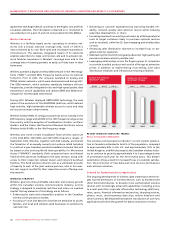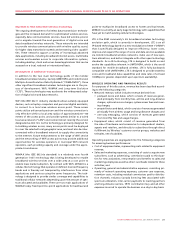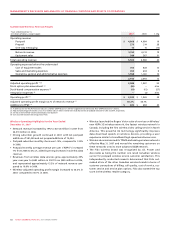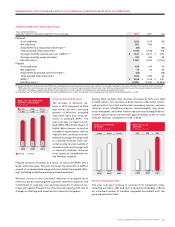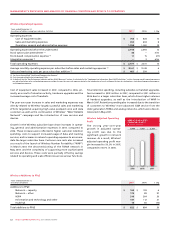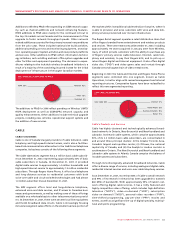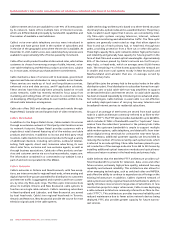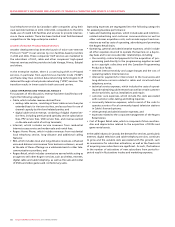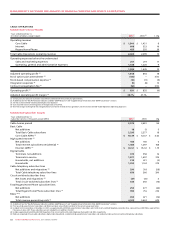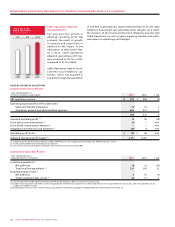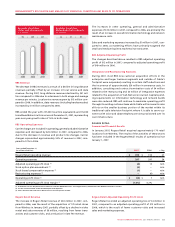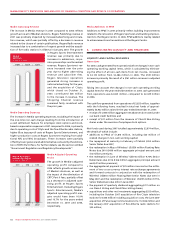Rogers 2007 Annual Report Download - page 40
Download and view the complete annual report
Please find page 40 of the 2007 Rogers annual report below. You can navigate through the pages in the report by either clicking on the pages listed below, or by using the keyword search tool below to find specific information within the annual report.
36 ROGERS COMMUNICATIONS INC. 2007 ANNUAL REPORT
MANAGEMENT’S DISCUSSION AND ANALYSIS OF FINANCIAL CONDITION AND RESULTS OF OPERATIONS
local telephone service by Canadian cable companies using their
own last mile facilities in 2005. Until 2005, competitors to the ILECs
made use of resold ILEC facilities and services to provide retail ser-
vice in these markets. There has been limited local facilities-based
competition in the large enterprise market.
Growth of Internet Protocol-Based Services
Another development has been the launch of Voice-over-Internet
Protocol (“VoIP”) local services by non-facilities-based providers
in 2005 and 2006. These companies’ VoIP services are marketed to
the subscribers of ILEC, cable and other companies’ high-speed
Internet services and the providers include Vonage, Primus, Babytel
and others.
In the enterprise market, there is a continuing shift to IP-based
services, in particular from asynchronous transfer mode (“ATM”)
and frame relay (two common data networking technologies) to IP
delivered through virtual private networking (“VPN”) services. This
transition results in lower costs for both users and carriers.
CABLE OPERATING AND FINANCIAL RESULTS
For purposes of this discussion, revenue has been classified accord-
ing to the following categories:
• Cable,whichincludesrevenuederivedfrom:
• analogcableservice,consistingofbasiccableservicefeesplus
extended basic (or tier) service fees, and access fees for use of
channel capacity by third and related parties; and
• digitalcableservicerevenue,consistingofdigitalchannelser-
vice fees, including premium and specialty service subscription
fees, PPV service fees, VOD service fees, and revenue earned
on the sale and rental of set-top terminals;
• Internet, which includes service revenues from residential
Internet access service and modem sale and rental fees;
• RogersHomePhone,whichincludesrevenuesfromresidential
local telephony service, long-distance and additional calling
features;
• RBS,whichincludeslocalandlong-distancerevenues,enhanced
voice and data services revenue from business customers, as well
as the sale of these offerings on a wholesale basis to other tele-
communications providers; and
• RogersRetail,whichincludescommissionsearnedwhileactingas
an agent to sell other Rogers’ services, such as wireless, Internet,
digital cable and cable telephony, as well as the sale and rental
of DVDs and video games and confectionary sales.
Operating expenses are segregated into the following categories
for assessing business performance:
• Salesandmarketingexpenses,whichincludesalesandretention-
related advertising and customer communications as well as
other customer acquisition costs, such as sales support and com-
missions as well as costs of operating, advertising and promoting
the Rogers Retail chain;
• Operating,generalandadministrativeexpenses,whichinclude
all other expenses incurred to operate the business on a day-to-
day basis and to service subscriber relationships, including:
• themonthlycontractedpaymentsfortheacquisitionofpro-
gramming paid directly to the programming suppliers as well
as to copyright collectives and the Canadian Programming
Production Funds;
• Internetinterconnectivityandusagechargesandthecostof
operating Cable’s Internet service;
• intercarrierpaymentsforinterconnecttothelocalaccessand
long-distance carriers related to cable and circuit-switched
telephony service;
• technicalserviceexpenses,whichincludesthecostsofoperat-
ing and maintaining cable networks as well as certain customer
service activities, such as installations and repair;
• customercare expenses,whichincludethecostsassociated
with customer order-taking and billing inquiries;
• communitytelevisionexpenses,whichconsistofthecoststo
operate a series of local community-based television stations
in Cable’s licenced systems;
• othergeneralandadministrativeexpenses;and
• expensesrelatedtothecorporatemanagementoftheRogers
Retail stores;
• CostofRogersRetailsales,whichiscomposedofstoremerchan-
dise and depreciation related to the acquisition of DVDs and
game rental assets.
In the cable industry in Canada, the demand for services, particularly
Internet, digital television and cable telephony services, continues
to grow and the variable costs associated with this growth, such
as commissions for subscriber activations, as well as the fixed costs
of acquiring new subscribers are significant. As such, fluctuations
in the number of activations of new subscribers from period-to-
period result in fluctuations in sales and marketing expenses.




